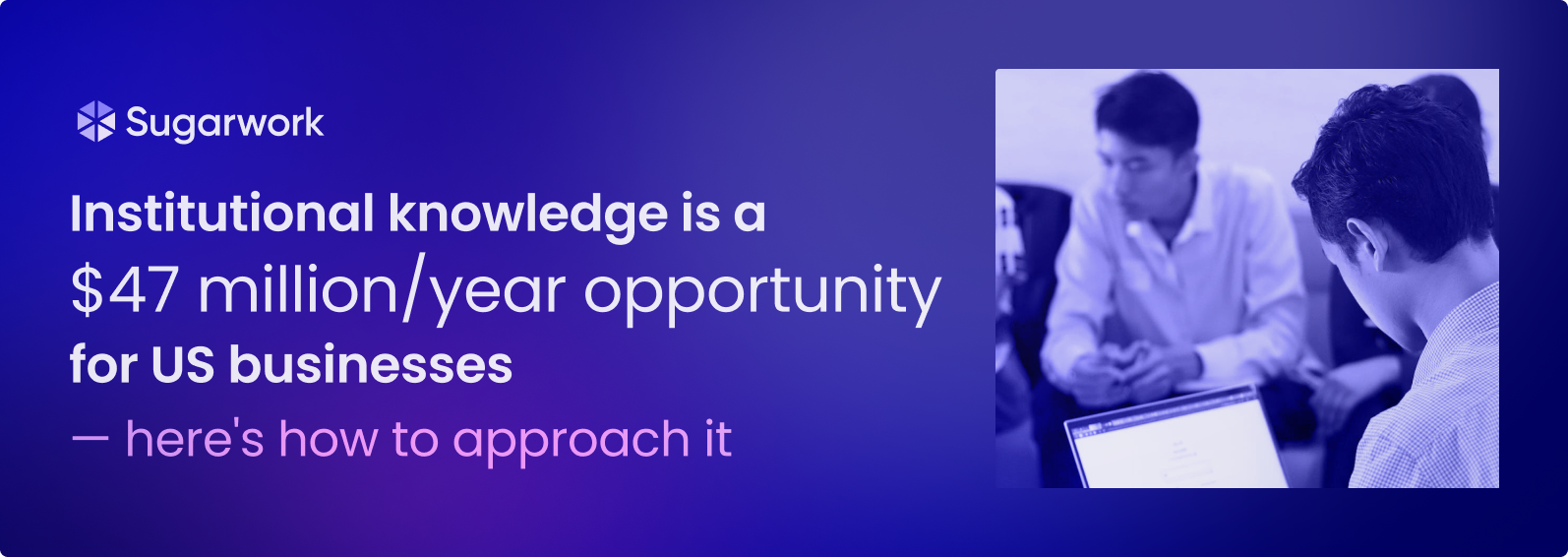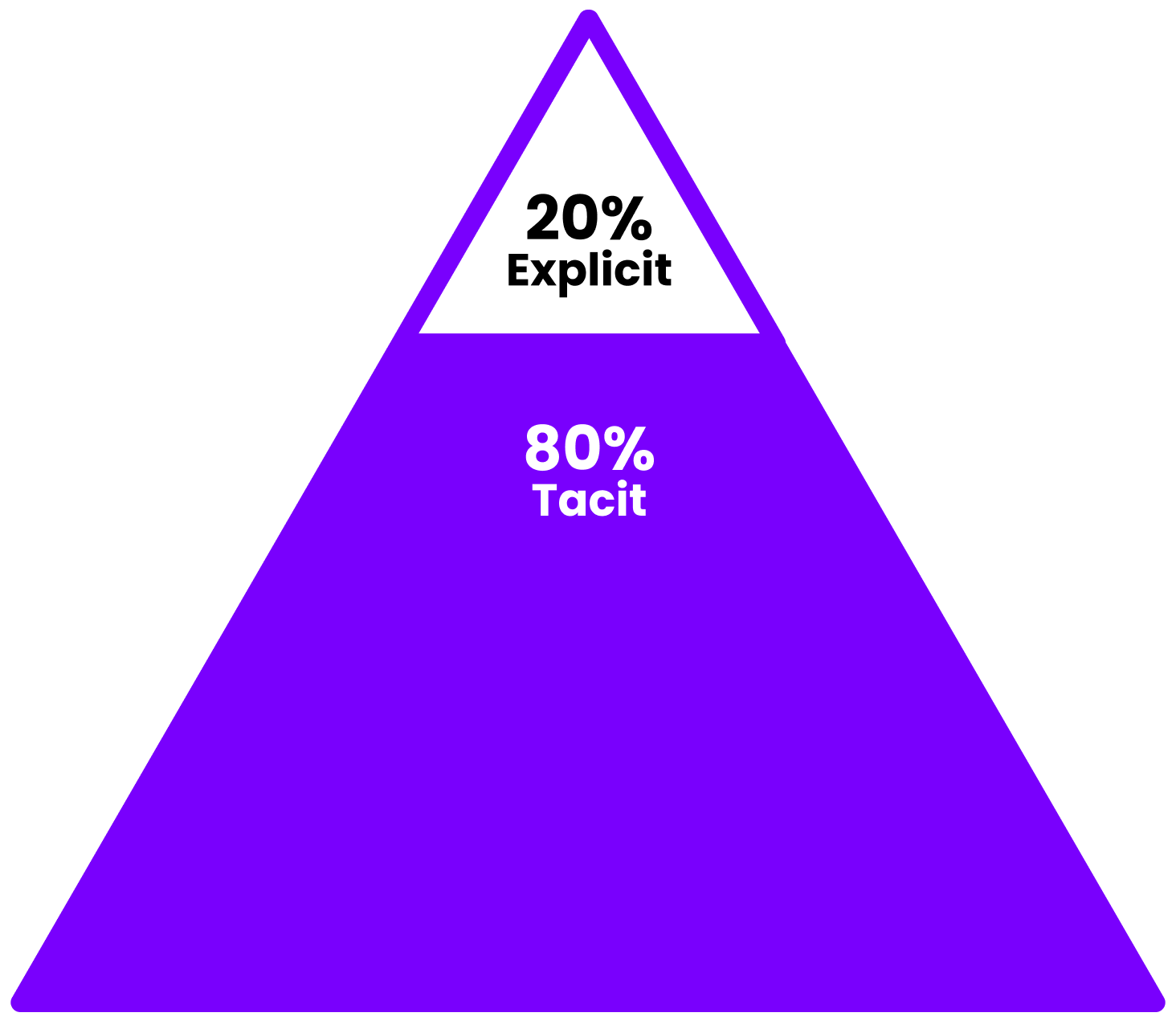Institutional knowledge is a $47 million/year opportunity for US businesses — here's how to approach it
You may have heard the story of the retired engineer who is called back to fix a machine after the business had already asked a number of expensive experts if they could solve the issue. The old man walks back in, grabs a hammer, and hits the machine in a specific place to get it started. The bill comes to $5,000 — $5 for his time, and $4,995 for knowing where to hit.
This parable illustrates a persistent, intractable, and expensive issue around the costs and opportunities of preserving institutional knowledge. The average large US business loses $47 million in productivity each year as a direct result of inefficient knowledge sharing, and knowledge workers waste over five hours every week either waiting for information from their colleagues or working to recreate existing institutional knowledge.
If the challenge of preserving and sharing institutional knowledge could be solved, the knock-on effects would be enormous; faster time to productivity for new hires, greater efficiency, and leaner, smarter, more innovative organizations.
However, there are a few key reasons why knowledge loss is so endemic, and it is worth unpacking each of these to really understand the barriers to success.
Eighty percent of institutional knowledge is tacit
First, the concept of institutional knowledge is poorly understood. And if you don’t understand what you are trying to maintain, your efforts are doomed before you begin.
A key incorrect assumption about institutional knowledge is it is limited to explicit knowledge, such as policies, SOPs, data, hard skills, techniques, processes, and values. To be clear, this kind of knowledge is absolutely critical. But it’s also only a part of the story.
80% of critical
knowledge in companies
is not documented
In actual fact, a huge part of institutional knowledge is tacit; the information that is held in people’s heads, and not captured in any formal system, or even necessarily easily expressed. According to some studies, as much as 80% of employees’ knowledge is tacit.
Due to this, tacit knowledge is difficult to define in detail until you look at specific situations within an organization. Here are some examples of tacit knowledge by department:
These are very specific examples, but there are countless more.
2. Tools are not built to capture the full spectrum of institutional knowledge
Over the last 12 months, we have surveyed 50 companies on what they are doing to capture tacit knowledge, and found that many leverage tools such as intranets, SharePoint, or even Microsoft or Google Docs. For example, one Fortune 50 pharmaceutical company used Microsoft docs and Sharepoint to capture knowledge during a spinoff of one of their divisions, with staff needing to refresh these every day to see new content. And a Fortune 100 airline was relying on spreadsheets to track experts in their organization.
These tools are not built explicitly for knowledge transfer. Therefore, they are time-consuming to set up and maintain, unwieldy in terms of enabling users to quickly find information, and difficult to scale. Furthermore, they are not designed to capture the huge untapped reservoir of tacit knowledge under the surface.
3. Management teams have a limited understanding of knowledge sharing across the organization
A common problem in large organizations is that management teams don’t know what they don’t know in terms of how employees really operate in their day-to-do workflow. While the high-level information of which teams work on which areas of the business or key projects is recorded, there is an entire sub-level of information regarding how people really collaborate across teams on the ground. This includes exactly who contributes expertise or time to projects, how knowledge is shared on an ad-hoc basis, and who is brought in for insights or relationship building.
4. Factors beyond your control can magnify the risks
Furthermore, a range of external factors can accelerate the risks involved with losing valuable institutional knowledge. These include any types of volatility, such as scaling, restructuring, or offshoring, megatrends such as the silver tsunami or shortening employee tenure, and situations in which critical legacy technology is central to the smooth operation of an organization, to name a few. When these kinds of challenges hit, there are many issues to solve immediately, and preserving institutional knowledge can frequently get lost in the chaos.
Knowledge loss can lead to outsized problems
Real-life examples of lost institutional knowledge causing outsized problems abound. For example, during one of many discussions we have had with enterprises about how they retain knowledge, one had lost the only person who knew how to operate its SAP Material Ledger. The company hired a consulting firm and spent $1 million just to be told that everything was indeed in working order. This is an expensive example of falling to capture tacit knowledge, and existing tools and limited visibility not being enough to spot the risk — but chances are, you have heard or even directly been through similar experiences yourself.
What you can do to preserve institutional knowledge
But on the other hand, there are a few key steps, and emerging technologies and tools, that are enabling organizations to take smarter, scalable approaches to capturing and sharing institutional knowledge. Here are a few key steps to get started:
Develop a strategy that includes tacit knowledge and can scale with sudden change
An effective strategy to capture institutional knowledge should include tacit knowledge. It should also take into consideration risk factors such as volatility, legacy technology and so on, so that if a crisis occurs, capturing valuable information from employees is one less thing you need to think about.Leverage technology to capture, curate, and share it
The rapid evolution of AI and new tools such as Sugarwork — a generative-AI powered platform to capture and share expert institutional knowledge — are offering smarter ways to make knowledge accessible to anyone in the organization, as well as the flexibility to ensure it is a living and evolving body of information.Make smarter decisions with the information
Beyond the valuable use case of peer-to-peer knowledge sharing, the information you capture can also be used to make data-backed strategic decisions. For example, beyond onboarding new employees, you may be able to identify where the overlaps and redundant efforts are in the organization, and/or understand where the relevant knowledge exists that can be applied to new markets.
How Sugarwork helped Appen reduce onboarding time by 70%
When AI data solutions company Appen underwent a restructuring process, they needed to transition engineering functions from one geography to another. With urgent tasks to complete including finding an office, hiring, and setting up the legal side of things, the management team was concerned that they didn’t have the infrastructure in place for knowledge transfer, and so they collaborated with Sugwork to make the process efficient and seamless.
With Sugarwork, Appen employees were able to scalably transfer knowledge on a secure and automated platform, utilizing generative AI to capture key insights. Experts and learners were paired on Sugarwork, and over a 6-week period, participants conducted over 250 sessions on Microsoft Teams, which were captured and summarized.
Sugarwork was key to reducing onboarding time by 70% through the sharing of knowledge across a global team of 100 engineers, and beyond the peer-to-peer knowledge transfer, Appen management was also able to better understand the true breadth of what areas which teams worked on, and where the overlap and duplications were.
Transform institutional knowledge from a cost to a competitive advantage
For large and enterprise businesses in particular, there is an enormous opportunity within a smarter approach to nurturing institutional knowledge and seeing it as a strategic advantage. Metrics you can improve include faster time to productivity for new hires, removing the risk of duplicated work across your organization, avoiding the need to hire expensive consultants to find out how systems were set up and maintained by previous employees, and even the potential to unlock new market opportunities.
If you recognize any of the challenges above, and would like to discuss in more detail about your own challenges around institutional knowledge capture and sharing, get in touch.
Request Demo
We'd love to hear from you. Please fill our form and a member of our team will be in touch shortly—we can't wait to meet you.




